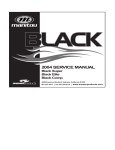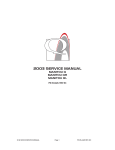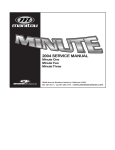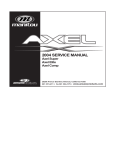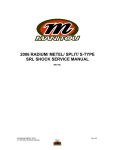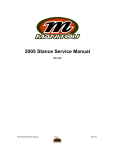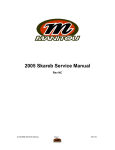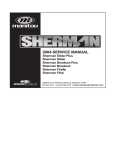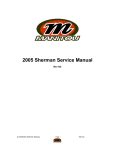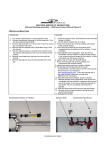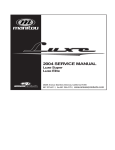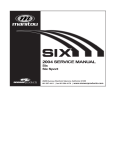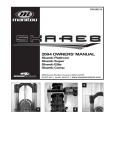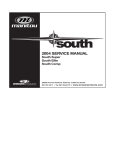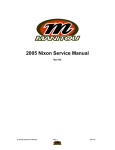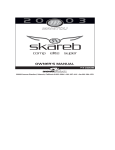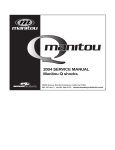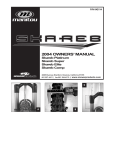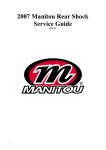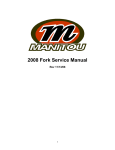Download Answer 2004 Skareb Service Manual
Transcript
2004 SERVICE MANUAL Skareb Platinum Skareb Super Skareb Elite Skareb Comp 28209 Avenue Stanford, Valencia, California 91355 661 257-4411 | fax 661 294-4179 | www.answerproducts.com Table of Contents Description Page Introduction 3 Glossary of Terms 4 Disassembly Instructions 8 Assembly Instructions 10 Bushing Removal and Installation Instructions 14 Troubleshooting Chart 18 Skareb Comp & Elite Schematic and Torque Specifications 20 Skareb Super Schematic and Torque Specifications 21 Skareb Platinum Schematic and Torque Specifications 22 Skareb Service Kit Chart 23 Contact Information Answer Products Customer Service Department 28209 Ave. Stanford Valencia, CA 91355 Toll Free: (800) 423-0273 Direct: (661) 257-4411 FAX: (661) 775-1798 E-mail: [email protected] [email protected] Web site: www.answerproducts.com 04 SKAREB SERVICE MANUAL Page 2 REV NC INTRODUCTION This manual is intended to guide the user through basic service of Manitou Skareb front forks. Service is supported by the identification of common parts and assemblies that have been assembled into Service Kits. The purpose of this manual will be to describe conditions that may drive the need for service and to provide installation instructions for the kits. Due to the time-consuming nature suspension fork service, at this time our primary focus is to offer service kits that minimize the amount of downtime and labor involved. Important information is highlighted in this manual by the following notations: WARNING Failure to follow WARNING instructions could result in severe injury or death to the person inspecting or repairing the suspension fork or the user. CAUTION A CAUTION a caution indicates special precautions that must be taken to avoid damage to the product. NOTE A NOTE provides key information to make procedures easier or clearer GENERAL WARNING: Suspension forks by design contain gases and fluids under extreme pressure and warnings contained in this manual must be observed to reduce the possibility of injury or possible death. Following these instructions can help you reduce the risk of being injured. Any questions in regards to the information in this manual should be directed to Answer Products Customer Service at (661) 257-4411. WARNING Suspension forks use compressed air to provide fluid pressure in the damping system and spring resistance in Air models. BOTH systems must be relieved of pressure prior to servicing these systems. Failure to relieve air pressure could result in injury or possible death. CAUTION: The Skareb suspension fork uses precision machined aluminum and other soft alloy components. Using correct tools for assembly is essential to prevent damage. 04 SKAREB SERVICE MANUAL Page 3 REV NC GLOSSARY OF TERMS Air Cap – Top cap that threads into top of air/spring leg (this is the left leg of the fork as you are seated on the seat). Forks may be controlled with an air/spring or a coil spring. The air cap contains the Schrader Valve, which is used to control the spring rate or SAG of air forks. Air Spring – A mechanism that is used to control the SAG of an air fork. Arch – A support that connects the two outer lower legs of the casting so as to keep them moving in unison. Boss – The word used to describe an outer casting that has brake posts for V-brakes or cantilever brakes. Bottom Out Bumper – A rubber or elastomer device that absorbs the shock that occurs when a suspension is compression to its limit. Bushings – A cylindrical sleeve between a fork stanchion tube (inner leg) and a fork outer casting (slider), which facilitates the sliding movement between these two parts. Coil Spring – A coiled piece of metal that acts as a spring to help suspend a fork. Compression – The phase of the suspension operation in which the wheel travels up, or travels closer to the frame. The suspension forks reaction to a bump in the trail. Compression Damping – Restriction of the rate that the suspension compresses under load. Crown Steerer Assembly – the stanchion legs (inner legs), the fork crown, and the steer tube pressed together as one assembly. This assembly is then finished by adding all of the fork internals and then outer casting (slider). Damping – A function that modifies the rate of suspension compression or rebound. Detent – An indentation that causes a rotating adjuster to stop at fixed increments. Drop Out – The end of an outer casting (slider) where the wheel attaches. FFD – Fluid Flow Damping. A Manitou patented low cost oil damping system. The compression damping is non-adjustable and the rebound damping may be non-adjustable or adjustable damping. 04 SKAREB SERVICE MANUAL Page 4 REV NC GLOSSARY OF TERMS (CONT.) Fork Crown – The component that joins the stanchion tubes (inner legs) to the steer tube of the fork. Hydraulic Fork Oil – Oil used in suspension designs to provide damping. It has special characteristics that determine how it reacts when exposed to compressed air, how it changes viscosity when its temperature changes, and how it moves through valves. Hydraulic Lock Out – a condition caused when the mixture of air and damping oil is out of balance. It is caused when there is too little air space in a chamber, not allowing the fork to compress through its travel. Lock Out – a special function that restricts the compression of the fork from moving. It is generally controlled by an external knob that is activated when a rider does not want the fork to move, thus eliminating extra energy needed to overcome the bobbing forces of the fork. MCU – (Micro-Cellular Urethane) Special urethane that is filled with tiny air cells that act like springs when the elastomer is compressed. No Boss - The word used to describe an outer casting that has no brake posts for V-brakes or cantilever brakes. This casting is to be used for disk brakes only. Oil Damping – A system that uses the resistance to oil flow through holes in a valve to provide a means to alter the rate of suspension compression or rebound. Oil Level – The level of damping oil needed for the optimal damping performance of a suspension. It is measured as the air space distance between the top of the stanchion leg (inner leg) and the height of the oil inside of the leg. The fork must be completely extended in order to get an accurate measurement. O-Ring – A soft, flexible neoprene or Buna rubber ring with a round cross-section, which is used for sealing and retention. Oil Weight – A description of the relative viscosity of oil, such as hydraulic oil. Oil with low weight numbers (5wt or 7wt) flow through valves with less resistance than higher weight numbers (10or 15 wt). Outer Casting – (see Slider) Preload – A condition of compressing a spring or elastomer before the operating loads are put on the suspension, so that it provides a stiffer spring rate. Piston – In front suspension, the part of the damper that slides back and forth inside of the damping leg that houses the valves. It can also refer to the air piston in the air/spring assembly that slides back and forth compressing the air, thus causing a change in the spring rate of the suspension. 04 SKAREB SERVICE MANUAL Page 5 REV NC GLOSSARY OF TERMS (CONT.) Porosity – The condition or property of having pores in a material that will allow gas or liquid to pass through it. Rebound – The phase of the suspension operation in which the wheel returns to its original position on the ground after compression. Rebound Damping – Restriction of the rate that the suspension rebounds when the compression load is relived. Reverse Arch Technology – Also known as RA. It is a system that is designed to move the arch of a fork to the backside of a fork, rather than the conventional front position. It was designed to provide greater rotational torque strength to an outer casting (slider), without adding additional weight to the fork. SAG – The amount a suspension fork compresses at rest with a normal load (rider’s weight). Schrader Valve – Valve used to introduce air into a chamber. Seal – A part, usually neoprene rubber or Buna, that keeps contaminants out and/or working fluids in. Semi Bath – A lubrication system that uses a lubricating oil to keep the bushing surface and stanchion legs (inner legs) as friction free as possible during movement of the stanchion legs. Spring Rate – The rate at which the resistance of a spring increases as it is compressed. SPV – (Stable Platform Valve) new damping system that allows the rider to set the pedaling platform that he desires to pedal most efficiently in all situations. It is dependent on the pressure that the SPV valve experiences from the movement of the wheel vs. the terrain and the platform that is set by pressure introduced to other side of the SPV valve through changes of air pressure working on the damping oil. Slider/Outer Casting – The tube (outer casting leg) of the suspension fork that remains fixed to the wheel. It slides up and down on the stanchion leg (inner leg). Stanchion Clamps - (Double-Triple Clamps) the portions of the fork crown that clamp around the stanchion legs above and below the head tube of the bicycle frame on specific long travel applications. Stanchion Legs – The suspension tube (inner leg) fixed to the fork crown. It remains stationary during the operation of the suspension. Steer Tube – The long cylindrical tube that extends from the top of the fork crown. Its function is to be inserted into the bicycle head tube and attach the suspension to the bicycle frame. 04 SKAREB SERVICE MANUAL Page 6 REV NC GLOSSARY OF TERMS (CONT.) Top Out Bumper – A rubber, coil spring, or elastomer device that absorbs the shock that occurs when the load is taken off a suspension so that it is allowed to rebound to its limits TPC – (Twin Piston Chamber) a patented damping system that has independent pistons for rebound and compression. The system utilizes a mixture of air and oil in the damping leg of the fork to enhance the damping performance. Travel – The amount that a wheel moves between the most compressed and the most extended states of the suspension Viscosity – A description of how a liquid flows. Liquids with higher viscosity are thicker flow less easily or quickly than liquids with low viscosity. This has an affect on the damping speeds of rebound and compression. Volume Control – A new system designed to work with SPV as a control of the compression ramp up rate of the fork. It has a range of adjustments from linear to very progressive. Wiper Seal – A rubber material that is used as a seal to keep dirt and water out of the outer casting legs. It is not designed to keep air pressure or extreme oil pressure in. Manitou has the new Evil Genius wiper seals. 04 SKAREB SERVICE MANUAL Page 7 REV NC 2004 Skareb Forks Disassembly and Rebuild Instructions Disassembly Instructions Removal of Outer Casting 1. From the left leg dropout (Left when sitting on the bike), use a 4mm hex wrench to remove the compression rod screw. 2. From the right leg dropout, if the fork has adjustable rebound, the knob will need to be removed. Remove the 2mm hex screw inside the knob and remove the knob. 3. Use a 8mm hex wrench to turn the damper clockwise until it can be pushed into the casting. 4. Remove crown/steer/inner leg assembly from the outer leg casting. 5. Position the bottom of the fork legs over a drain pan that is on the ground. Pull the casting downward towards the pan, allowing the Semi Bath oil in the casting to drip into the pan. Pull the casting completely off of the inner legs and wipe any excess oil off of inner legs and inside of casting. Bushing Removal & Installation Please refer to section on Bushing Removal & Installation. Removal of Compression Damping Assembly Forks with FFD (non-adjustable) Damping 1. Remove top leg cap (FFD Assy) on right hand side using 27mm socket. 2. Pour old oil out of the top of the fork, then compress fork upside down over oil drain pan 3-5 times to get oil out from under rebound piston and discard appropriately. Forks with Adjustable Compression/Lockout Damping 1. 2. 3. 4. Remove the 2mm fixing screw on top of the damper knob on top right side of the fork. Remove 2 balls and springs from inside the top cap. Unscrew the compression damping assembly using a 24mm socket. Pour old oil out of the top of the fork, then compress fork upside down over oil drain pan 3-5 times to get oil out from under rebound piston and discard appropriately. Removal of SPV Compression Damping Assembly WARNING This fork uses compressed air as part of the SPV damping system and must be relieved of pressure prior to servicing. Failure to relieve air pressure could result in injury or possible death. 1. If your fork has a red Schrader cap on the top right side of the fork, it is equipped with SPV damping. Remove Schrader valve dust cap from Red Hex Shaped Top Cap on the top right of the crown. Release all air pressure from the Schrader valve. 2. Remove SPV Volume Control Cap (Red Hex Shaped Top Cap) from top right of the crown with a 24mm Socket. Turn fork upside down over drainage pan to empty Damping oil from the inner leg. Stroke the Damper shaft on the bottom of the inner leg 3-5 times to purge the leg of oil that is caught below the oil piston. 04 SKAREB SERVICE MANUAL Page 8 REV NC Removal of Rebound Damping Assembly 1. Unscrew Damper end cap from the bottom of the right leg and then pull out the rebound damper. Removal of SPV Rebound Damping Assembly 1. If your fork had a red Schrader cap on the top right side of the fork when removing the compression damper above, it is equipped with SPV damping and will have the companion SPV rebound assembly. Unscrew damper end cap from the bottom of the right leg using a 24mm Open-end wrench or 8-10” Adjustable wrench and then pull out the SPV rebound assembly. 2. Checking the function of the SPV valve - Visually inspect the gap between the SPV valve and the bottom of the damping piston. It should have approximately 1mm of space. The valve should also spring back to its open rested position after compressing it with your fingers. If the valve is not responsive or all the time closed, it is bad and the rebound assembly needs to be replaced. Check for 1mm gap between the blue SPV valve and the black piston Removal of Air Piston and Compression Rod Assembly There are now two ways to remove the air piston from the inner leg. 1. An Air Piston Removal tool has been developed that will enable you to remove the piston without having to take the fork apart. (P/N: 85-8062). 2. Without this new tool, you will need to follow the procedures in the following section. WARNING This fork uses compressed air to provide spring resistance and must be relieved of pressure prior to servicing. Failure to relieve air pressure could result in injury or possible death. 1. Remove air dust cap covering the Schrader valves. a. Depress Schrader valve to release air pressure. b. Remove air cap on top of Left leg with 20mm socket. 2. Remove rebound adjuster knob using a 2mm hex wrench. 04 SKAREB SERVICE MANUAL Page 9 REV NC 3. From the right leg dropout, use 8mm hex wrench to turn the damper shaft clockwise until it can be pushed into the casting. 4. Remove 11mm hex bolt (Compression Rod bolt) from bottom of Left leg. 5. Remove crown/steer/inner leg assembly from the outer leg casting over a drain pan, because Semi Bath oil will leak out of bottom of casting once you pull the inner legs from the outer casting legs. 6. Be sure to drain all Semi Bath oil out of casting before re-assembly of fork. 7. Remove left leg end cap and compression rod assembly from inner left leg. Then remove spring and Air piston rod. 8. Use a long narrow rod approximately 18”/458mm long and no greater than _”/7mm in diameter and insert it into the left inner leg from the bottom of the leg. Be sure to direct the rod through the center of the negative spring assembly that is about halfway up the inner leg. Once the rod has contacted the air piston, use a rubber mallet and tap the piston out through the top of the inner leg. Tapping Piston out with long rod Assembly Instructions Assembly of Air Piston and Compression Rod Assembly WARNING All leg caps for Damper and Spring systems must be properly tightened prior to use. Failure to do so could result in injury or possible death. 1. Apply a small amount of Prep M grease onto the threads at the top of the left inner leg with your finger. 2. Apply a small amount of Prep M grease around the outside diameter of the new air piston. 3. Insert the air piston (metal side up) into the inner leg through the threaded area at the top of the inner leg. Use your fingers to push the piston past the threads into the leg. Air Piston is inserted into inner leg with metal side facing up 04 SKAREB SERVICE MANUAL Page 10 REV NC 4. Re-install the air push rod, positive spring (that has been well greased), and compression rod assembly. Tighten per the Fastener and Torque Values section. 5. Pour about 3cc of a 40wt or greater automotive oil into the top of the piston and then install the air cap assembly. Tighten the air cap assembly 30-50in/lbs. Make sure to apply a thin layer of grease to inner threads and outside of piston before installation. Pour 3 cc of oil into top of piston 6. Fully extend the damper shaft and slide the rubber bumper against the inner leg end cap. Insert the crown/steer assembly into the outer legs to the upper bushing. Holding the fork horizontal, inject 16cc of 5-40wt Semi bath oil into the hole at the bottom of each outer leg (Figure 2). A syringe works well for this procedure. 7. Push the outer legs past the lower bushing and reinstall the 4mm bolt and tighten 8mm damper fitting in a counterclockwise direction. Tighten per the Fastener and Torque Values section. 8. Use a shock pump (p/n 85-4069) to fill the air system to the recommended levels as outlined in the Fastener and Torque Values section. Reassembly of Crown Steer/Leg Assembly WARNING All top caps for Damper and Spring systems must be properly tightened prior to use. Failure to do so could result in injury or possible death. WARNING All leg caps for Damper and Spring systems must be properly tightened prior to use. Failure to do so could result in injury or possible death. 1. Grease the outside of the air piston and then apply a thin film of grease to the threads at the top of the inner leg. It is recommended to use Prep M grease (P/N: 85-0031). Push the piston into the top of the left inner leg with the metallic side of the piston facing you, using your thumb. Push the piston past the threads and then pour approximately 3-4cc’s of a 20-50wt oil (P/N: 85-0022) into the top of the piston. This oil needs to be checked about every 6-8 weeks of riding time. It will dissipate over time and then you may experience some air leakage and increased stiction in the fork movement. 2. Install the air cap and tighten it to value given on fork schematic. 3. Turn crown/steer/leg assembly over, so that the bottoms of the inner legs are facing you. In the same leg that you just installed the air piston and air cap into; insert the air push rod (longer end in first), then the positive spring (this is your ride kit spring) onto the short end of the push rod, then install the compression rod assembly, and tighten end cap into leg. Tighten to torque values that are listed on fork schematic. 4. Now, install damping assembly into bottom of other inner leg. If your fork uses SPV damping, be sure to check the function of the SPV valve and apply a thin layer of Prep M grease onto 04 SKAREB SERVICE MANUAL Page 11 REV NC o-ring that is around the piston at top of assembly. Install the assembly and tighten end cap to specified torque value. Assembly of Compression Damping Assembly - Non-Adjustable FFD WARNING All top caps for Damper and Spring systems must be properly tightened prior to use. Failure to do so could result in injury or possible death. 1. Put a little bit of Prep M grease (Ref Answer Products PN 85-0031) on o-ring found on the lower piston of the FFD assembly. 2. Install the FFD Assy into the top right hand of the crown/steer using a 27mm socket. Tighten per the Skareb Schematic and Torque Specification Table. Assembly of Compression Damping Assembly - Adjustable Compression/Lockout WARNING All top caps for Damper and Spring systems must be properly tightened prior to use. Failure to do so could result in injury or possible death. 1. Fill right leg with damping oil using 5wt Motorex fork oil (Ref Answer Products PN 850023) to the height noted in the Skareb Schematic and Torque Specification Table. Cover the opening at the top of the right leg of the crown/steer with a rag and cycle the fork six times. Recheck oil level and add/drain to meet the level requirement. 2. Put a little bit of Prep M grease (Ref Answer Products PN 85-0031) on the urethane or brown rubber o-ring found on the lower piston of the Lock out assembly. 3. Twist the Hex shaped aluminum shaft that sticks up from the top cap counter clockwise until it stops (the system is completely open to oil flow at this point). 4. Using a motion like screwing in a screw. Twist the assy. and apply a little pressure to insert the piston part of the mechanism past the threads at the top of the inner leg. Then push the assy. into the leg until the threads on the cap intersect the threads inside the inner leg, screw the cap. Tighten per the Skareb Schematic and Torque Specification Table. 5. Once the cap is tightened, twist the Hex shaped shaft clockwise until it stops (this is the locked out position). Insert the springs into opposite holes in the top cap and then place the ball bearings on top of the springs (place a little dab of grease on spring to hold ball bearing in place). 6. Place the adjuster knob onto the hex shaped aluminum shaft and seat it onto the top cap and ball bearing. Position the adjuster cap so that the lever part of the cap is at the farthest point to the back of the crown. 7. Insert 2mm fixing screw and tighten to secure the knob. Twist the knob counter clockwise to activate the fork suspension. Compress the fork several times to circulate the oil through the system and then activate the Lock out system by moving the lever clockwise to its stopping point at the back of the crown. The fork should have approximately 5 mm of progressive travel before it locks out. Note: This system is a combination of adjustable compression damping that becomes a lock out. It is fully active when the lever is facing all the way forward (counter clockwise) and locked out when the lever is facing all the way towards the back of the crown (clockwise). Assembly of Compression Damping Assembly - SPV WARNING All top caps for Damper and Spring systems must be properly tightened prior to use. Failure to do so could result in injury or possible death. 1. Insert the Volume control assembly into the top of the right inner leg and tighten per the Skareb Schematic and Torque Specification Table. Be sure that you unscrew the red 04 SKAREB SERVICE MANUAL Page 12 REV NC 16mm Hex shaped Volume control nut all of the way counterclockwise after you tighten the entire assembly into the inner leg. Use: the Manitou Volume Control Adjuster (P/N: 85-3007) to do this. Installation of Outer Leg Casting WARNING When installing the outer Leg Casting to the Crown Steer Assy, Compression Rod bolts and Damper Shafts must be properly tightened prior to use. Failure to do so could result in injury or possible death. 1. Turn completed crown/steer/leg assembly upside down, so that the compression rod and damper shaft are facing you. You will see a bottom out bumper on the damper shaft; slide this bumper down towards the end cap that is threaded into the inner leg. This will help in keeping the shaft extended as you install the outer casting. 2. Pressurize the air spring to 100psi; this will help keep the compression rod extended as you install the outer casting. 3. Press inner legs into casting about half way and then inject Semi Bath oil (5/40wt. synthetic oil, P/N: 85-0022) into outer casting, holding fork at 45 degree angle to the ground with bottom of fork in the air (drop outs up). Inject 16cc’s of oil into each outer leg. It is recommended to use a syringe to inject oil. 4. Finish sliding inner leg assembly into outer leg casting until damper shaft contacts casting. 5. Use an 8mm hex wrench to turn the damper shaft counterclockwise, threading it into the casting. Tighten per the Skareb Schematic and Torque Specification Table. 6. Install rebound adjuster knob if applicable. Knob should turn uninhibited until the indicator is stopped by the casting. If not, remove knob and reinstall on hex shaft in 1/6 turn increments until full travel is reached. 7. Install the 4mm compression rod screw and tighten per the Skareb Schematic and Torque Specification Table. 04 SKAREB SERVICE MANUAL Page 13 REV NC Bushing Removal & Installation Bushing Removal (Note: use appropriate removal ring that corresponds to the leg diameter of the fork being repaired) Leg Diameter 25.4mm (1”) 28.6mm (11/8”) 30mm 32mm Answer Kit # 85-5191 85-5189 85-5194 85-5192 Bushing Removal Tool Components A. Slide Hammer B. Threaded Handle C. Slide D. Threaded Shaft E. Removal Ring Bushing Removal Tool Assembly 04 SKAREB SERVICE MANUAL Page 14 REV NC Bushing Removal (CONT.) Bushing Removal Instructions A. Install 25.4mm Removal ring on the shiny, smaller diameter threaded shaft. Be sure to install the ring with the tapered, chamfered end first, followed by the long slide tube. This tapered end leads the tool through the bushing. B. Start the procedure by removing the Dust/Wiper seal with a screwdriver, prying it out. C. Insert Removal tool past the upper bushing and then stop. It is important to pull one bushing out at a time. Push the slide on the threaded shaft down towards the removal ring. Hold the casting with one hand and the slide hammer with your other hand. Now move the slide hammer in a motion away from the casting and repeat this action until the bushing comes out. D. For all other leg diameters: use the larger diameter (dark colored) threaded shaft and repeat steps A-C. Bushing Installation (Note: Sizer kits listed in above chart contain the sizers needed for each specific leg diameter.) (1) (2) Bushing Installation Tool Components 1. Installation Mandrel 2. Threaded Rod w/nuts 3. Sizer rings 4. Spacer 5. Washer 6. Nut (3) 04 SKAREB SERVICE MANUAL Page 15 (4) (3) (5) (6) REV NC Bushing Installation (CONT.) Bushing Installation Tool Assembly With weighted handle When selecting sizer rings to install bushings, choose the two rings that are in the middle of the size run to start with. 1. Assemble installation tool as shown in picture above. Each leg diameter kit has all of the needed pieces to remove and install bushings for forks with serviceable bushings. Some of the kits come with gauges to tell you how far to drive in the lower bushings. Upper bushings are driven in as far as the stop in the top of the casting will allow. The general rule of thumb is that the lower bushings must not be driven any deeper than 5” into a casting leg. If they do go deeper, call Customer Service at Answer Products – 800-4230273 for a new outer casting. 2. Always assemble Mandrel with the larger diameter sizer ring being placed on the mandrel first, then the spacer, the next largest sizer ring, followed by the washer and the nut to hold it in place. Be sure to lock the nut above the Mandrel and below the Mandrel against each other. 3. Replace the lower bushing (bushing with a thicker wall diameter) first. Place a small amount of Prep M grease onto the sizer rings to help the rings come through the bushings when pulling them out. Slide bushing onto Mandrel until it stops. Apply a bead of Red Loctite all the way around the outside of the bushing. Hold casting on top of bench with a rag under the end of the legs and insert installation tool with bushing into casting leg. 04 SKAREB SERVICE MANUAL Page 16 REV NC Bushing Installation (CONT.) 4. Slide weighted handle onto end of threaded rod and tap rod into casting with rubber Mallet until proper depth is achieved. If using depth gage, slide gage onto rod before installing weighted handle and let it settle on of Mandrel. Tap rod until appropriate line on gage is even with top of casting leg. 5. Remove weighted handle and gage (if applicable). 6. For sizing of the lower bushing: 7. Use slotted top cap from sizer kit and set it into the top of the casting leg, straddling the threaded rod. Spin the extra nut with washer down to the top cap and using a wrench, socket, or speeder wrench, tighten the nut in a clockwise direction. This will cause the Mandrel to be pulled through the bushing, thus sizing it. Keep turning the nut until the tool is all the way through the bushing and can be pulled out of the leg. 8. To install top bushings, repeat steps B-E. Note that the top bushing gets inserted until it stops against the step inside of the casting. The extra sleeve that comes with the sizer kit is used to space the top cap off of the casting, so that there is enough room to pull the sizers out of the casting without bottoming on the cap. 9. If you find that the bushings are too tight after installing them, use the sizer Mandrel that does not have a stop on it to hold the bushing while installing it into the casting. This is available in the 25.4mm leg kit (85-5191) to go back in and resize the bushings. 10. To resize bushings, Choose the next larger size rings and repeat the above process. 11. When satisfied with the results, reinstall Dust/wiper seals and then reassemble fork 04 SKAREB SERVICE MANUAL Page 17 REV NC TROUBLESHOOTING Symptom Air Loss Oil leaks from Wiper Seals Oil leaks from bottom of Casting Lack of Travel Loss of SPV damping Cause Solution Schrader Valve leaks Tighten Valve core, replace bad parts as needed. Air Cap O-ring leaks Make sure O-ring is seated properly, replace parts as needed. Air Piston leaks Check oil volume on top of piston, replace parts as needed. Air Top Cap leaks Check O-ring, tighten cap to proper Torque, replace parts as needed. Seal not seated properly Remove Casting from Inner Legs, reinstall or replace seals Nicks or scratches on inner legs Replace Crown/Steerer/Inner Leg Assembly Too much Semi Bath oil Follow instructions for removal and installation of Outer Casting Wear Remove Casting from Inner Legs, reinstall or replace seals Rebound damper shaft leaks Replace Rebound Damping assembly Rebound damper shaft Oring damaged Replace O-ring on threaded end of Rebound Damping assembly Compression Rod Bolt leaks Check O-ring on bolt to see if it is damaged and then reinstall Tight Bushings Hydraulic lock out Resize bushings or replace with new ones if damaged Replace Rebound Damping assembly Semi Bath oil volume Follow instructions for removal and installation of Outer Casting Damper oil volume Check oil level, Replace Rebound Damping assembly if needed Fork alignment Visually inspect fork, call Answer Products Customer Service SPV valve not functioning Inspect for damage, check valve gap, replace assembly if needed Damper oil volume Check oil level, refer to "Oil leaks from bottom of Casting" Rebound knob does not turn Replace Rebound Damping Assembly Loss of SPV air pressure Refer to "Air Loss- Schrader valve leaks and Air Cap O-ring Leaks" 04 SKAREB SERVICE MANUAL Page 18 Service Manual Page REV NC TROUBLESHOOTING (CONT.) Symptom Cause Fork Top out Loss of Rebound Damping Replace Rebound Damping assembly SPV Valve not functioning Refer to " Loss of SPV Damping - SPV valve not functioning" Top out spring damaged Inspect and replace Top out spring if needed. Damping oil volume not correct Check oil level, Replace Rebound Damping assembly if needed Too much SAG Refer to SAG Set up in Tuning section of Owners Manual Bottom out Bumper damaged Inspect and replace Bottom out Bumper if needed Damping oil volume not correct Check oil level, Replace Rebound Damping assembly if needed Loose bushings Resize bushings or replace with new ones if damaged Loose Compression Rod bolt Tighten bolt to specified torque Loose Rebound damping shaft Tighten Shaft to specified torque Loose press fit tolerances Call Answer Products Customer Service Fork Bottom out Play in Fork 04 SKAREB SERVICE MANUAL Solution Page 19 Service Manual Page REV NC Skareb Comp & Elite: Fastener Torque and Setup Levels Description Model: Skareb Comp & Elite Torque Values Torque – Brake Post 90–110inlbs (10.2-12.4nm) Bushing Depth – Upper *8.9mm Min. (.35”) Bushing Depth – Lower Air Preload Cap: *99 – 106 mm (3.9 - 4.2”) Torque 50inlbs (5.7nm) Schrader Valve Torque 3-5inlbs (.34-.57nm) Leg Caps 25–35inlbs (2.8-4.0nm) Torque - Comp Rod Screw *15 – 61KgCm (13 – 53inlbs) Torque - Damper Screw *15 – 24KgCm (13 – 20inlbs) Adjuster caps & Top Caps 35-50inlbs (4.0-5.7nm) Semi Bath Oil Volume 16cc per leg Damping Oil Damping oil Level - Non SPV 04 SKAREB SERVICE MANUAL 110 – 120mm (4.3 – 4.7”) Page 20 REV NC Skareb Super: Fastener Torque and Setup Levels Description Model: Skareb Super Torque Values Torque – Brake Post 90–110inlbs (10.2-12.4nm) Bushing Depth – Upper *8.9mm Min. (.35”) Bushing Depth – Lower *99 – 106 mm (3.9 - 4.2”) Air Preload Cap: Torque 50inlbs (5.7nm) Schrader Valve Torque 3-5inlbs (.34-.57nm) Leg Caps 25–35inlbs (2.8-4.0nm) Torque - Comp Rod Screw *15 – 61KgCm (13 – 53inlbs) Torque - Damper Screw *15 – 24KgCm (13 – 20inlbs) Adjuster caps & Top Caps 35-50inlbs (4.0-5.7nm) Semi Bath Oil Volume 16cc per leg Damping Oil Damping oil Level - Non SPV 04 SKAREB SERVICE MANUAL 110 – 120mm (4.3 – 4.7”) Page 21 REV NC Skareb Platinum: Fastener Torque and Setup Levels Description Model: Skareb Platinum Torque Values Torque – Brake Post 90–110inlbs (10.2-12.4nm) Bushing Depth – Upper *8.9mm Min. (.35”) Bushing Depth – Lower Air Preload Cap: *99 – 106 mm (3.9 - 4.2”) Torque 50inlbs (5.7nm) Schrader Valve Torque 3-5inlbs (.34-.57nm) Leg Caps 25–35inlbs (2.8-4.0nm) Torque - Comp Rod Screw *15 – 61KgCm (13 – 53inlbs) Torque - Damper Screw *15 – 24KgCm (13 – 20inlbs) Adjuster caps & Top Caps 35-50inlbs (4.0-5.7nm) Semi Bath Oil Volume 16cc per leg Damping Oil Damping oil Level - Non SPV 110 – 120mm (4.3 – 4.7”) Damping oil Level – SPV for 80mm Travel Forks 68 – 72mm (2.7 – 2.8”) Damping oil Level - SPV for 100mm Travel Forks 73 – 77mm (2.9 – 3.0”) 04 SKAREB SERVICE MANUAL Page 22 REV NC Skareb Service Kits Skareb Model Comp Code Super Platinum M-410 M-411 M-415 M-416 M-420 M-421 M-430 M-431 80 100 80 100 80 100 80 100 Travel (mm) Comp Rod/ Elite H 80 85-5264 100 85-5264 85-5583 85-5264 85-5583 End Cap Assy 85-5264 85-5583 85-5583 85-5320 Air Push Rods 80 85-4439 100 85-4439 85-4474 85-4439 85-4474 Knob Kit I 85-5584 Seal Kit K 85-5265 Air Piston Kit G 85-5266 Bumper Kit K 85-5267 O-Ring Kit K 85-5268 Bushing Kit E 85-5324 A 85-5559 B 85-5587 A 85-4467 85-4439 85-4474 85-4474 85-5585 Options: *Damping **Lock Out **SPV Rebound **SPV Vol. Adj. 04 SKAREB SERVICE MANUAL Page 23 REV NC























